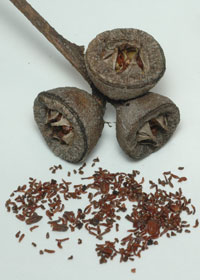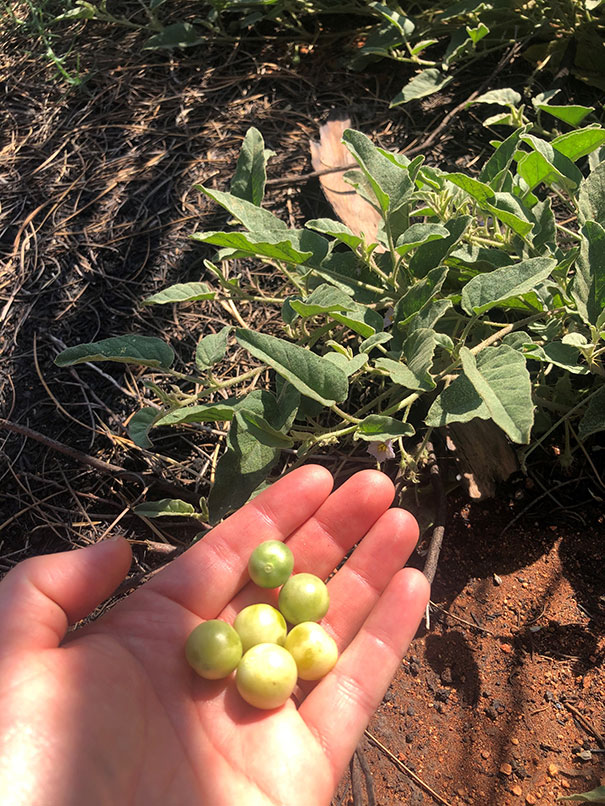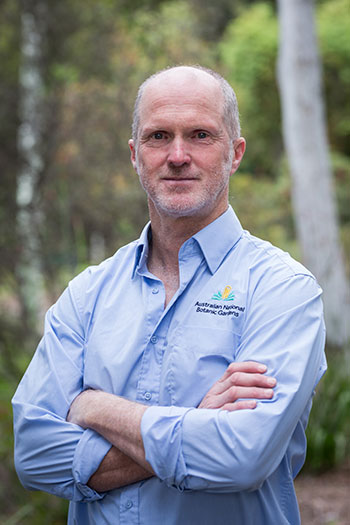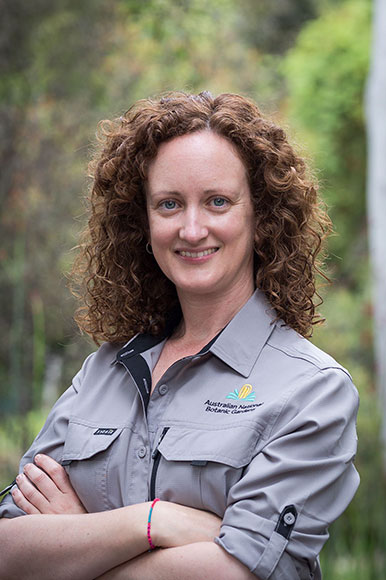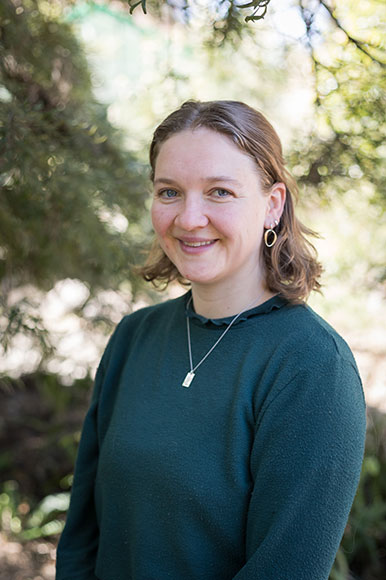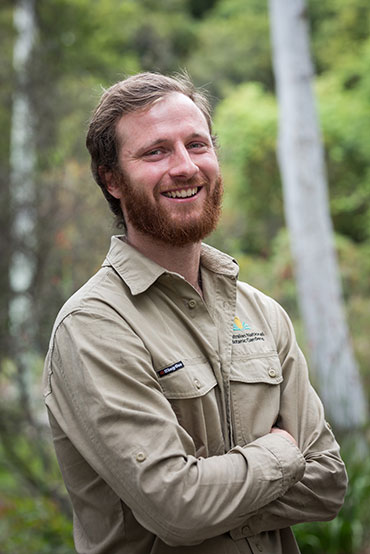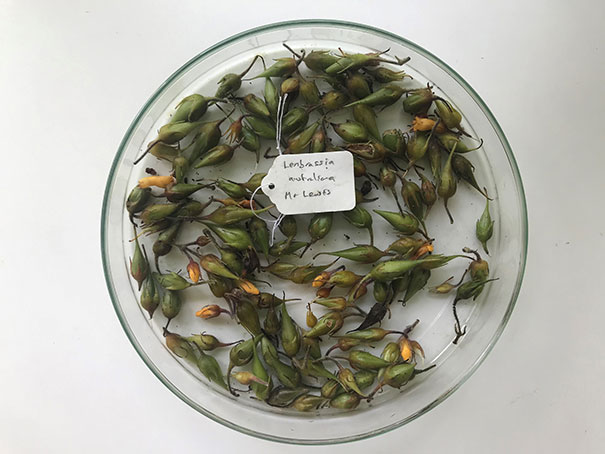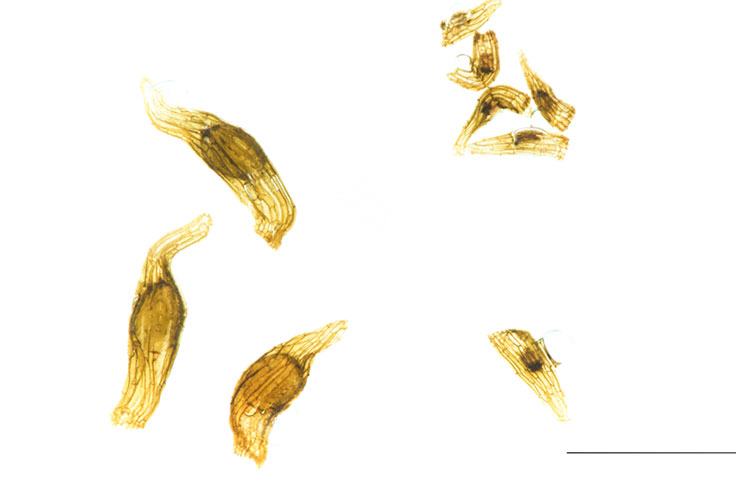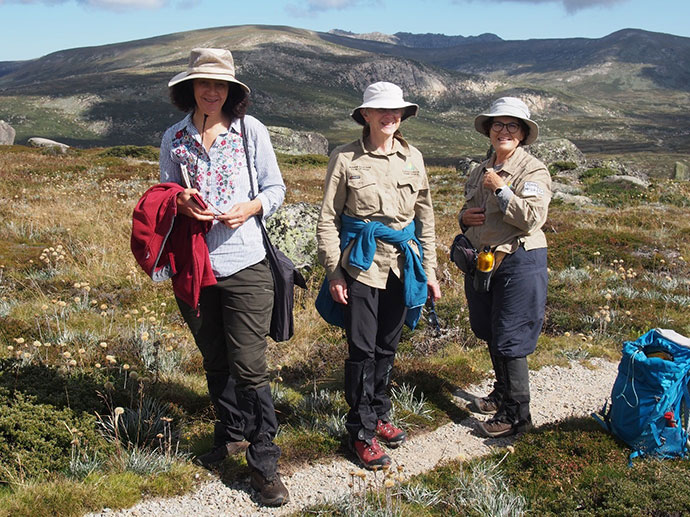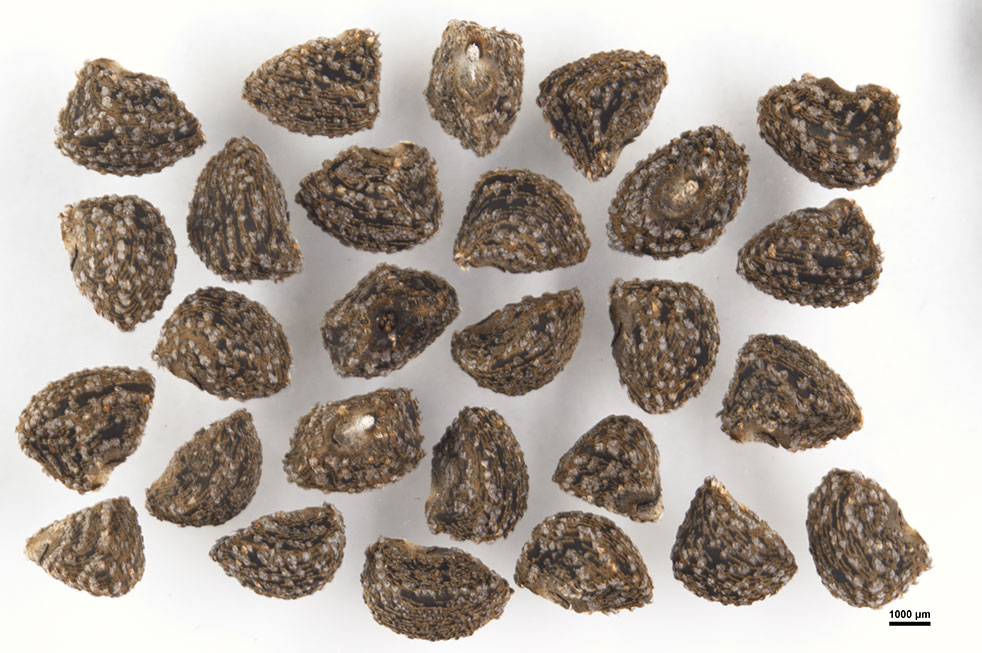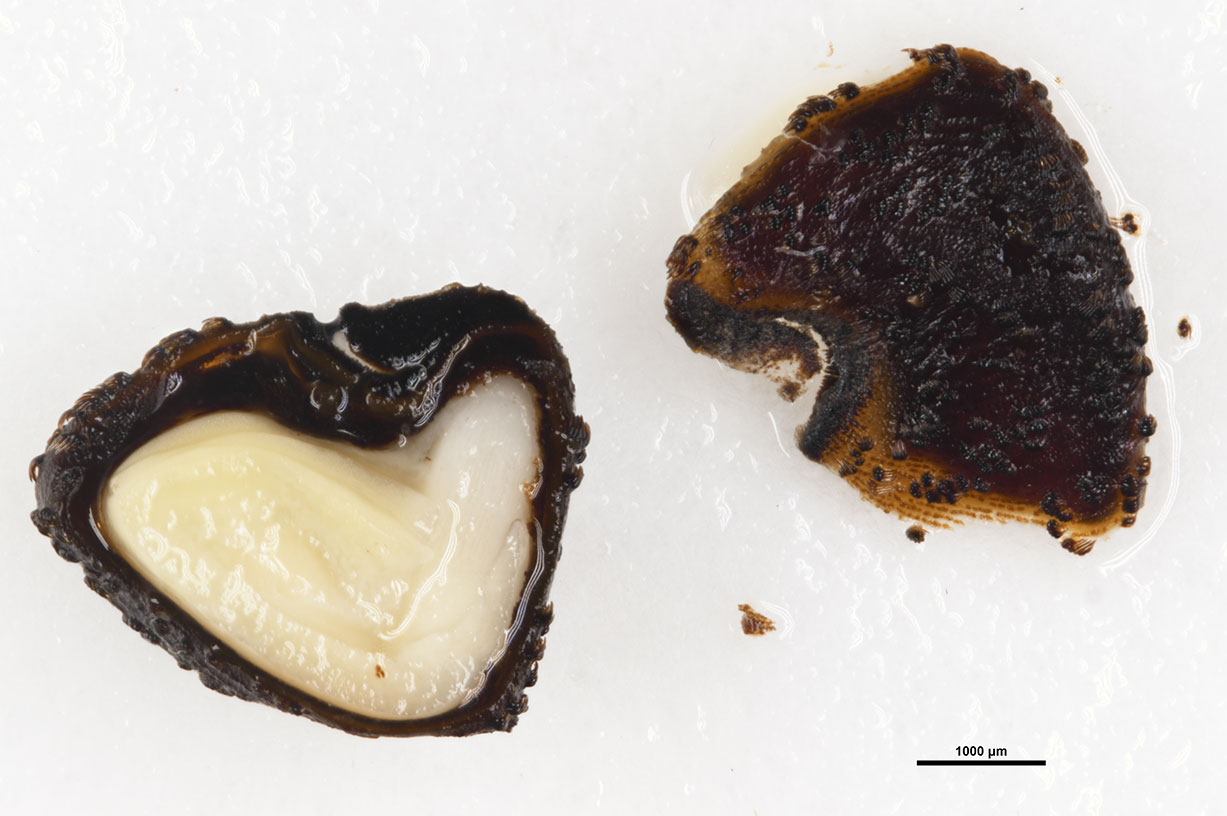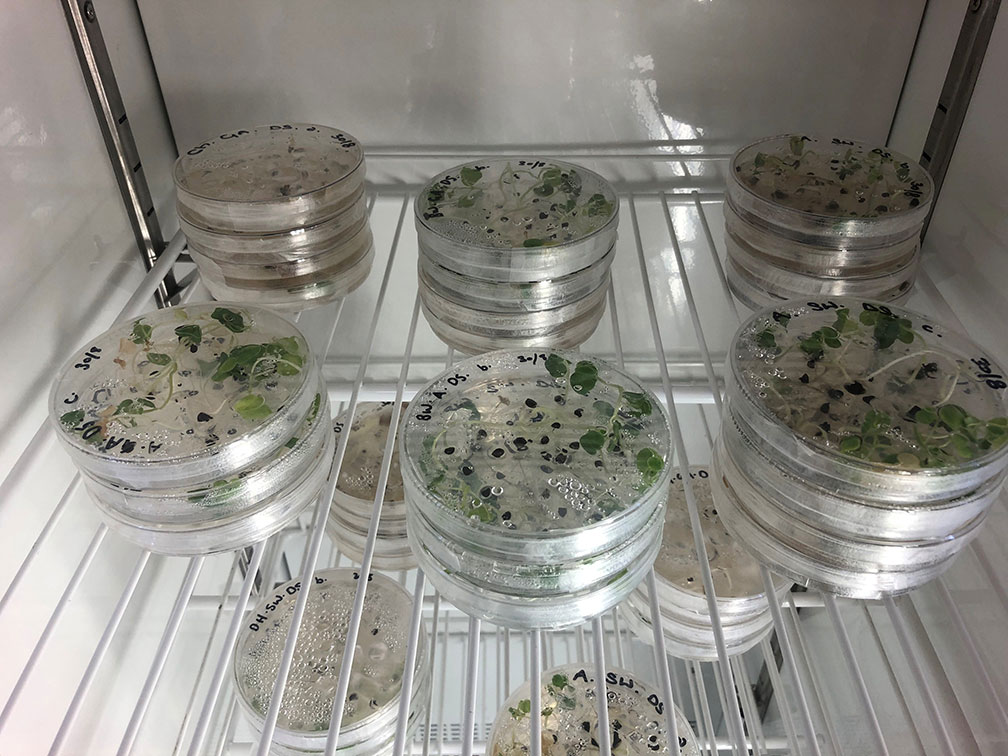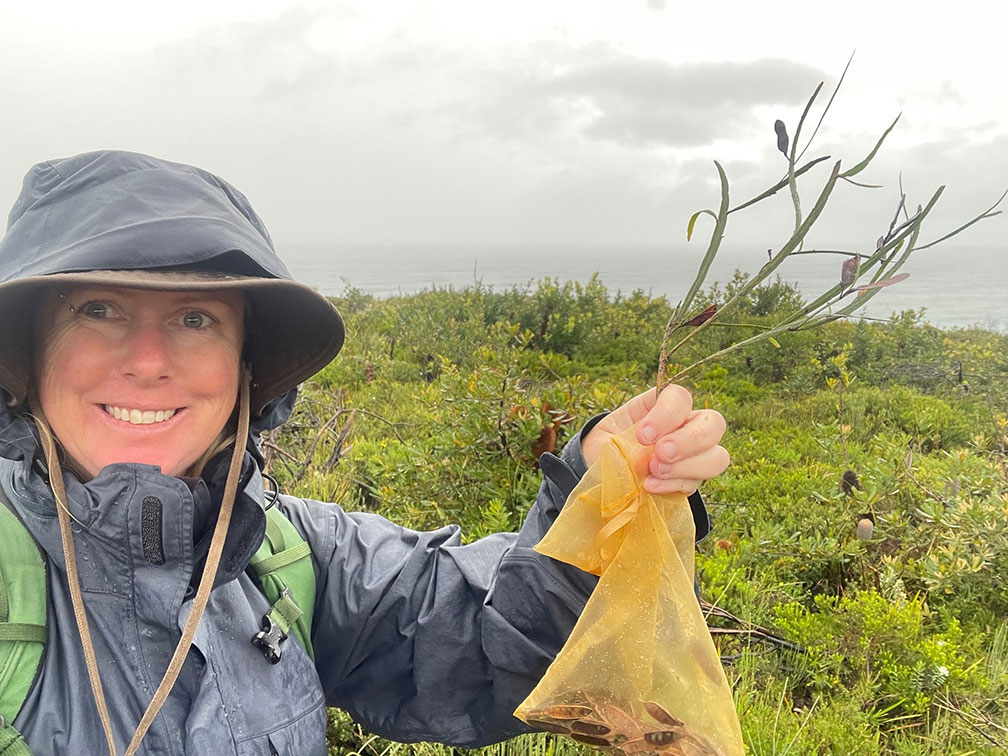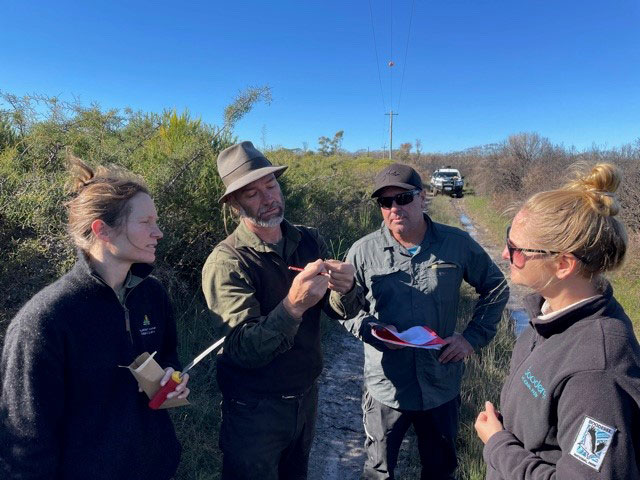The National Seed Bank
Overview | People | Partnerships | Research & Conservation Projects | Research Publications | Databases | Supply of Seed | Contact
Overview
Australian plant biodiversity continues to be lost at a rapid rate. While in situ conservation remains vital, it needs to be supported through the collection and storage of seeds and other germplasm (plant reproductive material) in conservation seed banks. Each seed holds all the genetic information needed to reproduce a plant, provided its viability is maintained and its germination requirements are known. Seed banking allows the preservation of high levels of plant genetic diversity at relatively low cost, in minimal space and for comparatively long periods. Seed collections safeguard against extinction in the wild, support future on-ground conservation, restoration and reintroduction of plants, and provide an immense resource for researching biological and physiological processes crucial to understanding how plants function, now and in the future. The importance of insurance collections such as those in conservation seed banks is recognised in the Australian Government's Threatened Species Action Plan 2022–32.
The National Seed Bank has a crucial role to play. It holds more than 8,000 seed accessions (individual seed collections, normally stored in a single packet) from almost 4,000 different plant taxa, 139 of which are listed threatened species (under the EPBC Act 1999). Collections have been made all over Australia and date back to the early 1960s.
The National Seed Bank is part of Parks Australia and is located at the Australian National Botanic Gardens in the Australian Capital Territory (ACT). Reflecting this, it specialises in collections of seed from species from the ACT and surrounding region, and of species from Australia's Commonwealth Parks. The National Seed Bank collection is an integral part of the ex situ collections of the Australian National Botanic Gardens (ANBG) and holds both short- and long-term collections.
- Short-term seed collections are used for research and to support the ANBG's nursery with stock of new and replacement native plant species for display.
- Long-term conservation collections are stored to assist in safeguarding Australian native plants.
Our purpose and functions
The purpose of the National Seed Bank is to protect against plant extinction and build knowledge of the Australian flora through integrated collecting, storage, and research on germplasm.
This is achieved through delivery of seven core functions:
- Seed collecting—gathering of seed from target species growing in priority areas.
- Collections management—curating, maintaining and testing a long-term collection that supports conservation and research.
- Research—Conducting seed-related research to understand factors influencing seed germination and longevity in storage to inform both in situ and ex situ conservation.
- Seed supply—making seed and seedlings available for research and conservation.
- Specialist training—building capacity in the wider sector, especially to help train the next generation of seed scientists.
- Research publication—communication with scientific and conservation audiences to contribute knowledge for better plant conservation outcomes.
- Outreach—engagement with the public to promote ex situ conservation.
Seed collecting
Seed collecting activities currently target locations in the ACT and surrounding region, and the Commonwealth Parks. Collecting focuses on threatened species but also includes species in threatened communities, and culturally or ecologically significant species. The provenance of all wild collected seed is comprehensively recorded, and voucher specimens are housed and catalogued in the Australian National Herbarium.
Collections management
The curation and management of collections and their associated data are critical tasks necessary to achieve the best possible conservation outcomes from our collecting efforts. The National Seed Bank undertakes curatorial work in line with contemporary best practice seed banking methods and international standards where feasible. Duplicate seed collections are stored for safekeeping with other seed banks in Australia through the Australian Seed Bank Partnership, or the Millennium Seed Bank Kew (UK). Conventional seed banking techniques are appropriate for 'orthodox' seeds that can tolerate drying to low moisture content and storage at -20°C. Seeds stored in the National Seed Bank have the potential to remain viable for hundreds of years. In contrast, 'recalcitrant' seeds are desiccation sensitive and require alternative storage methods such as cryopreservation (a process where biological material is frozen to preserve the plant tissue for an extended period of time).
Facilities
The National Seed Bank has a fully equipped laboratory with germination incubators, thermogradient germination plates, a laminar flow cabinet, seed X-ray machine and microscopes for assessing seed morphology. For long-term seed conservation there is a purpose-built drying room (15°C, 15% relative humidity), cleaning and packaging areas and several freezers (-20°C).
People
The National Seed Bank has a small team of staff who are trained specialists in their fields. They are supported by more than 30 highly engaged and skilled volunteers.
Staff
Dr Lydia GujaManager, National Seed Bank & Seed Conservation BiologistLydia is the Manager of the National Seed Bank team within the ANBG and is a Seed Conservation Biologist at the Centre for Australian National Biodiversity Research (a joint venture between Parks Australia and CSIRO). Lydia's research focuses on achieving applied conservation outcomes for native Australian plants, through an understanding of the biology, ecology and stress tolerance of seeds. She investigates seed conservation biology, seed ecology, seed physiology, functional traits, stress tolerance, and landscape restoration. |
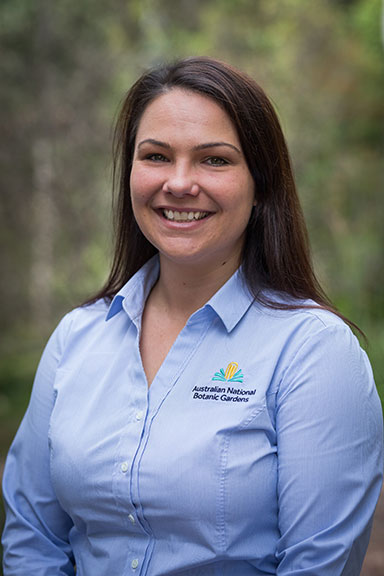 |
Volunteers
The National Seed Bank is supported by a team of volunteers, many of whom are sourced from the Friends of the ANBG, that help with a variety of important tasks.
The support that volunteers provide is invaluable to the National Seed Bank. Two main programs guide these efforts, the Seedy Volunteer Program and Curation Volunteers.
Members of the Seedy Volunteer Program began collecting seeds in the summer of 2011–12 and each summer the group targets threatened species and communities within the ACT and surrounding NSW to support research, recovery and restoration efforts.
The Curation Volunteers provide assistance with seed preparation, cleaning and specimen photography within the National Seed Bank.
Volunteers also assist with research experiments in the laboratory.
Partnerships
The National Seed Bank works with many national and local partners to help deliver plant conservation and research objectives. Our capacity to meet the aims of ex situ conservation is greatly enhanced by these organisations and the people we work with.
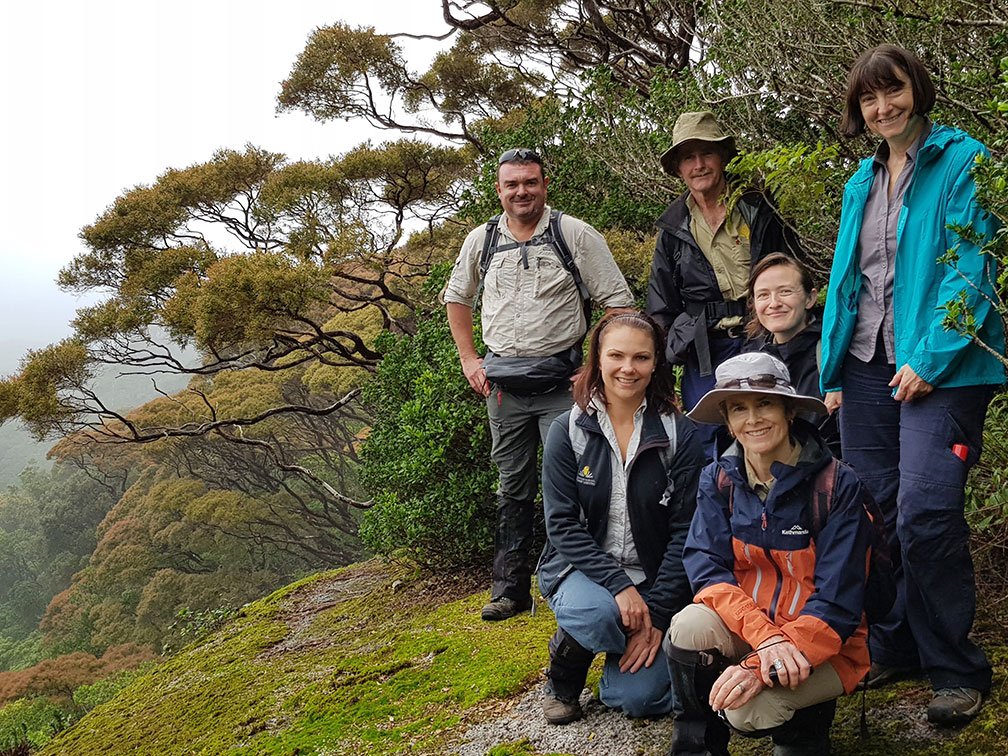
Australian Seed Bank Partnership
We are members of the Australian Seed Bank Partnership (ASBP). The ASBP is an Australia wide initiative, with 13 plant conservation agencies, aimed at a national effort to conserve Australia's native plant diversity through collaborative and sustainable seed collecting, banking, research and knowledge sharing for optimal outcomes in plant conservation and restoration. The National Seed Bank has contributed to multiple projects coordinated by the ASBP, delivering collections from Commonwealth National Parks including Kakadu, Booderee, Uluru-Kata Tjuta, Norfolk Island and Christmas Island.
In September 2021 the ANBG, with the ASBP, hosted the Australasian Seed Science Conference which was attended by 425 participants from 34 countries. International and national experts presented on a range of topics covering seed dormancy and germination, storage behaviour, ex situ conservation, seed ecology and cultural seed banking.
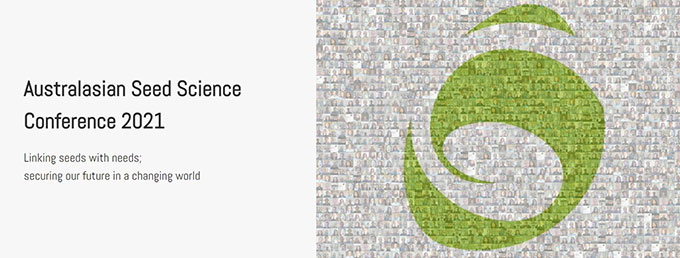
Millennium Seed Bank Partnership
The National Seed Bank, through ASBP, is a member of the Millennium Seed Bank Partnership (MSBP), the largest ex situ plant conservation program in the world. The MSBP is coordinated by the Royal Botanic Gardens Kew in the United Kingdom. Where possible, primary collections are kept in the country of origin with duplicates being sent to the Millennium Seed Bank for storage.
Centre for Australian National Biodiversity Research
The Centre for Australian National Biodiversity Research (CANBR) is a joint venture between the Director of National Parks and the CSIRO. The National Seed Bank supports the CANBR's research through joint venture staff and by providing seed material, laboratory access and data on seed collections. The Australian National Herbarium, within CANBR, verifies and houses the voucher specimens linked to the seed collections.
Australian Network for Plant Conservation
The ANBG also has a long-term partnership with the Australian Network for Plant Conservation (ANPC). Together with the ANPC, many staff from the National Seed Bank, ANBG and Parks Australia were involved in producing the third edition of the Plant Germplasm Conservation in Australia guidelines. These guidelines showcase the latest techniques, literature and procedures for optimising germplasm storage and use. Germplasm is stored as seeds in conservation seed banks, as living plant collections in botanic gardens and nurseries, as tiny shoots grown in tissue culture, as fern spores and fungal filaments, and even as cryo-stored seeds or plant parts. The book is written as a guide for conservation agencies, scientists, nursery and seed bank staff, students, volunteers, restoration practitioners and anyone else interested in applied plant/seed biology and conservation.
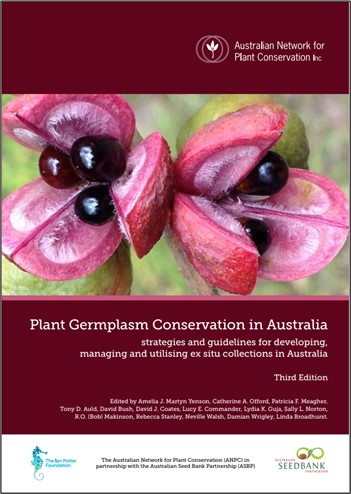
There is an increasing focus in the work of the National Seed Bank on plants of importance to First Nations people. Partnerships with Traditional Owners and other members of Aboriginal communities are important to represent Indigenous knowledge, perspectives and aspirations in our germplasm collection, collections management and research.
Research & Conservation projects
By conducting seed-based research, the National Seed Bank team is extending our knowledge of collecting, storing and germinating native seeds as we increase the number of different plant species held in our bank.
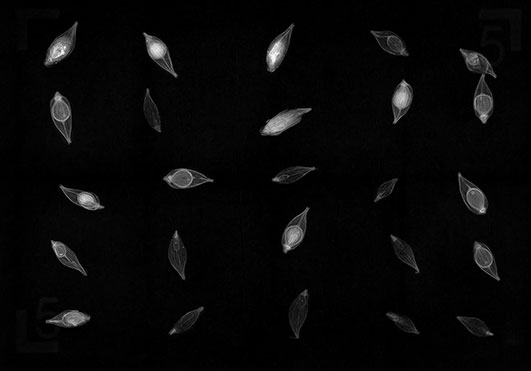
We focus our investigations on:
- Germination requirements of native seeds, including treatments that alleviate or bypass seed dormancy, so that collections can be used and plants propagated in the future.
- Seed longevity studies to inform long-term seed conservation methods and collection management.
- Alternative storage conditions such as cryo-storage for short-lived and desiccation-sensitive seeds and other plant germplasm (e.g. fern spores).
- How seed traits influence plant responses to environmental stress so that we understand what drives plant regeneration and species distribution in situ and how this might change in the future.
Staff at the National Seed Bank work individually and collaboratively with a range of partners on many different projects. Read further below to learn about some of the projects that we're currently working on. Recent research publications by NSB staff and partners are also available via this web page.
Southeastern Australia
Orchids
National Seed Bank staff have been collecting seed of threatened orchid species that occur in local grasslands and grassy woodlands. We have focused on multiple populations of three main species: the Canberra Spider Orchid (Caladenia actensis), the Tarengo Leek Orchid (Prasophyllum petilum) and the Brindabella Midge Orchid (Corunastylis ectopa). Usually once seeds are collected they are cleaned, dried and the quality or 'viability' of each collection is estimated in what's known as a 'tetrazolium chloride staining test' or TZ test. In the TZ test, living embryos stain bright red. However, due to the small size and unique morphology of orchid seeds, the traditional TZ test methods often don't apply. Seed Bank staff are currently developing new tests for orchid seeds to efficiently determine collection viability prior to banking. This work aims to ensure that we are banking high quality, genetically diverse seed collections of threatened orchid species for long-term ex situ conservation and associated research.
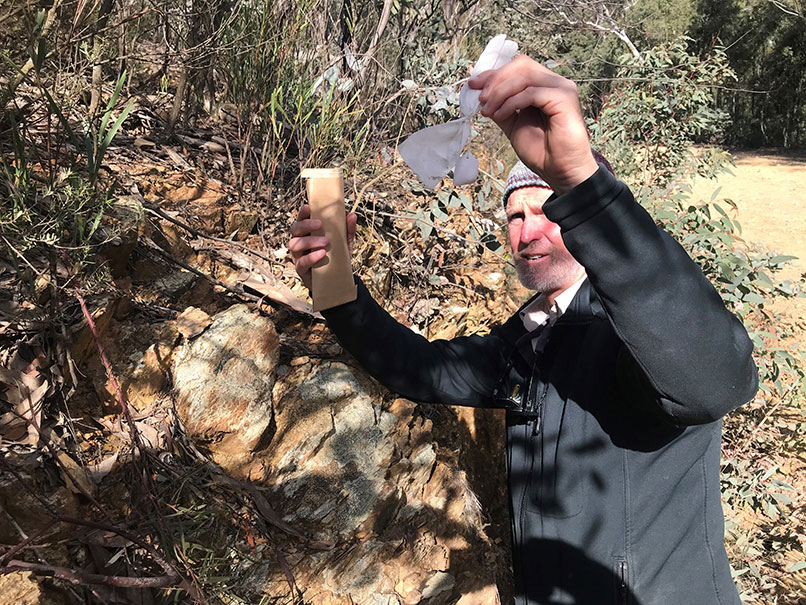 |
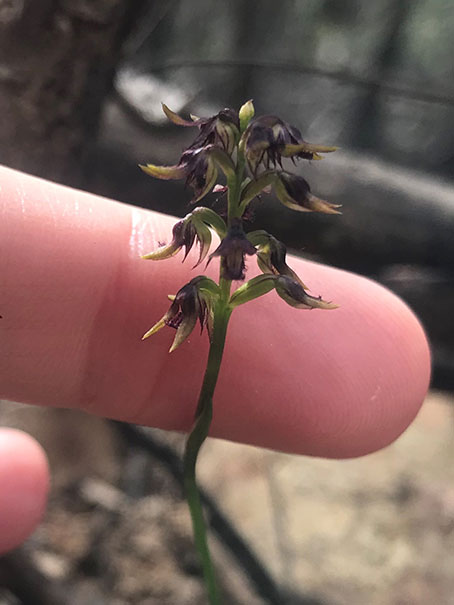 |
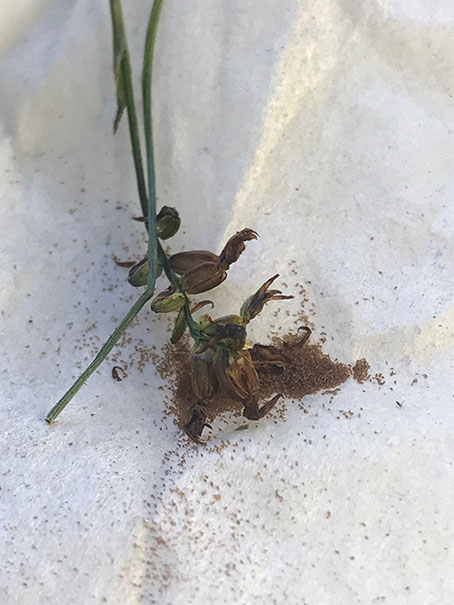 |
| Tom North, National Seed Bank, bagging seed capsules of Corunastylis ectopa (Orchidaceae). | ||
Alpine
The Australian National University, the ANBG and the Friends of the ANBG have been collaboratively researching Australian alpine seed ecology. Outcomes include a significantly increased number of alpine species held in the National Seed Bank. Associated research is helping to determine the impacts of climate change, including the 2019/2020 bushfires, on the reproductive ecology and demography of Australian alpine flora.
Sub-alpine
In response to the catastrophic bushfires of 2019/2020 the National Parks Conservation Trust initiated the Survive and Thrive project to secure genetic material of plant species impacted by the fires. As part of this project, the National Seed Bank has collected and banked material of an initial five priority species with a further seven species targeted in future years. All target species were known to be rare and had most of their populations burnt in the bushfires. Prior to this work these species were not represented in the collections of any conservation seed bank. With these species now secured as either seed or cuttings, scientific research can utilise these collections to investigate storage characteristics and germination cues. This in turn will inform protocols on how to propagate and conserve these species for long-term conservation. More detail on this project can be found at Survive and Thrive, Australian Alps | National Parks Conservation Trust.
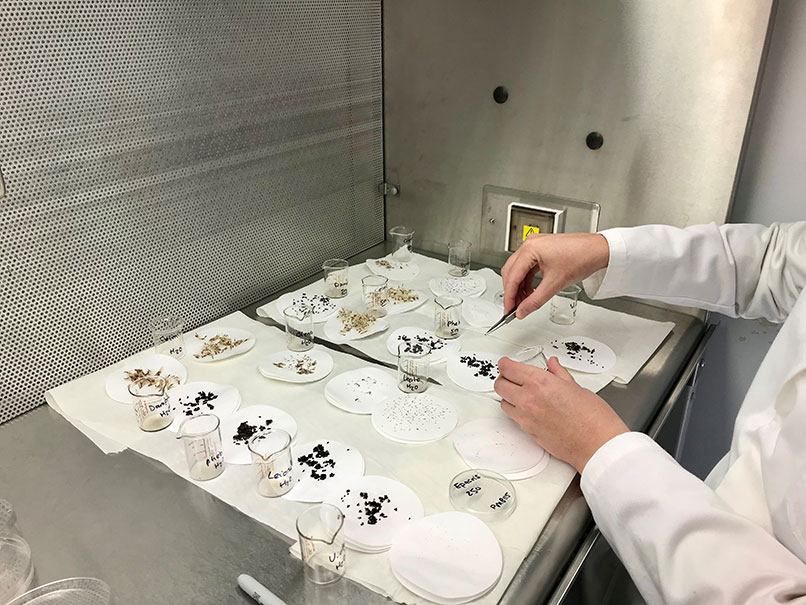 |
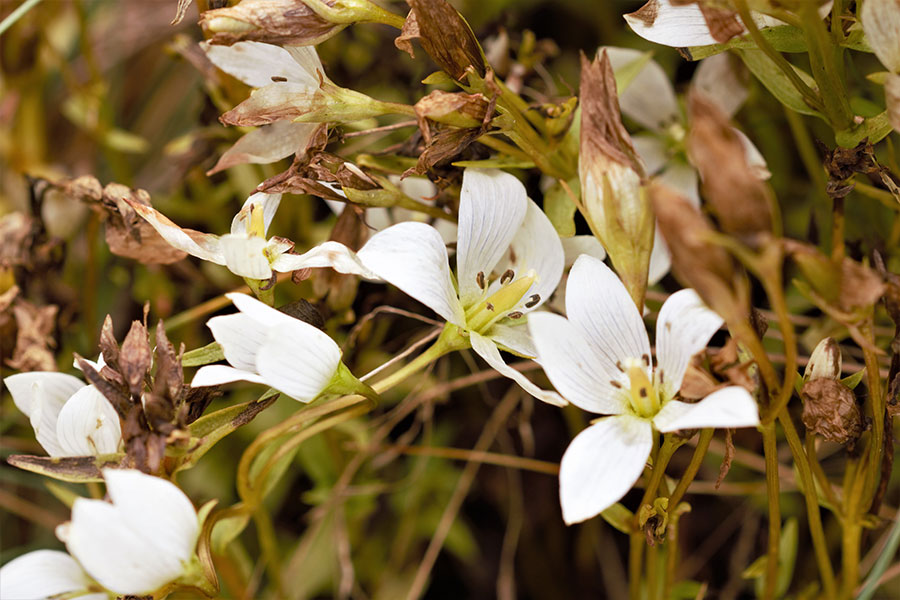 |
Left: investigating fire cues. Right: Gentianella flowers. |
|
Grassy ecosystems
Grasslands and grassy woodlands are critically endangered ecosystems within the Australian Capital Territory (ACT). This project aims to increase the genetic diversity and number of species being conserved, and to improve methods for restoration through an increased understanding of the seed biology and propagation of some of the key species from these plant communities.
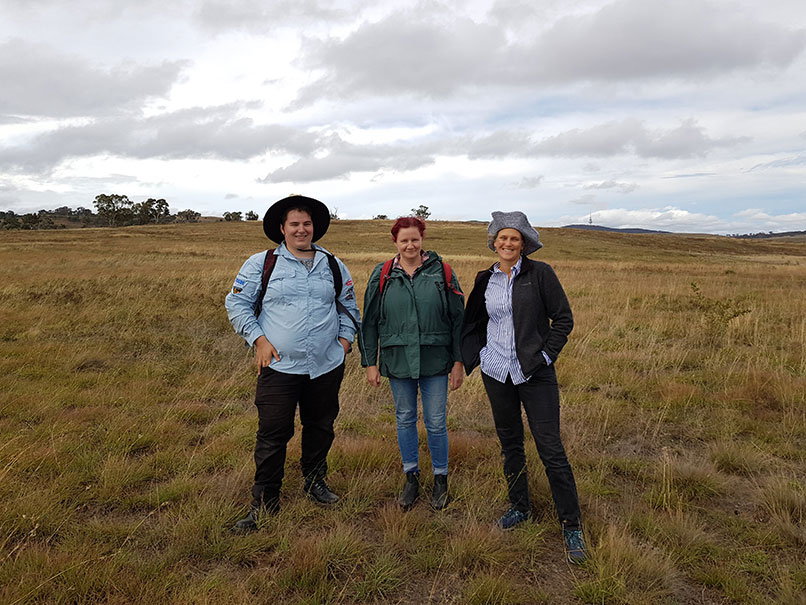
Commonwealth Parks
The National Seed Bank operates within Parks Australia, as part of Australia's Commonwealth Government. Parks Australia is responsible for six terrestrial national parks, 60 marine parks and the ANBG. The terrestrial parks are Booderee National Park, Kakadu National Park, Uluru-Kata Tjuta National Park, Christmas Island National Park, Norfolk Island National Park and Botanic Garden, and Pulu Keeling National Park. The National Seed Bank holds significant collections from most of these areas to support park management and to contribute to national conservation initiatives.
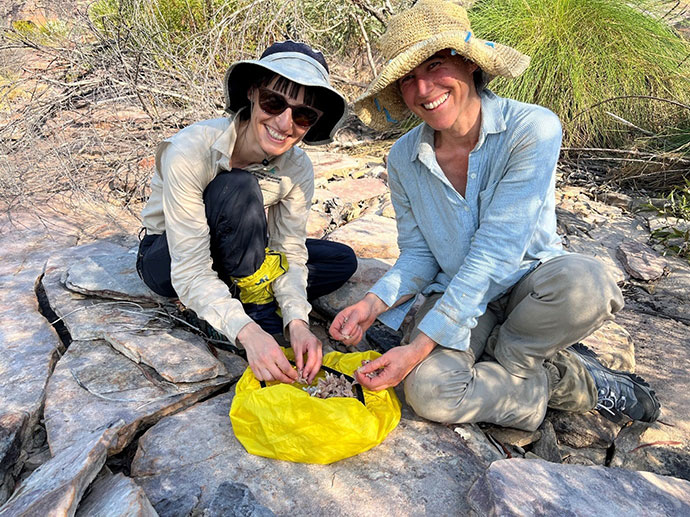
The National Seed Bank aims to collect and bank seeds of all the threatened and culturally significant plant species naturally occurring in these parks. This will significantly increase the representativeness and diversity of collections secured in the National Seed Bank.
Christmas Island
The National Seed Bank is working with Christmas Island staff to bank seeds and spores and build an understanding of the seed biology of Christmas Island flora to support plant conservation and restoration initiatives. For example, the National Seed Bank currently supports the ex situ conservation of the critically endangered fern Pneumatopteris truncata. Spore samples collected from Christmas Island are stored at the National Seed Bank and were used to propagate and establish now mature individuals in the Australian National Botanic Gardens tropical greenhouse. These plants will continue to be monitored, studied, and used to inform future propagation trials to be conducted on the island to further support the conservation of the ferns. A number of these plants will be displayed in the ANBG's Ian Potter National Conservatory.
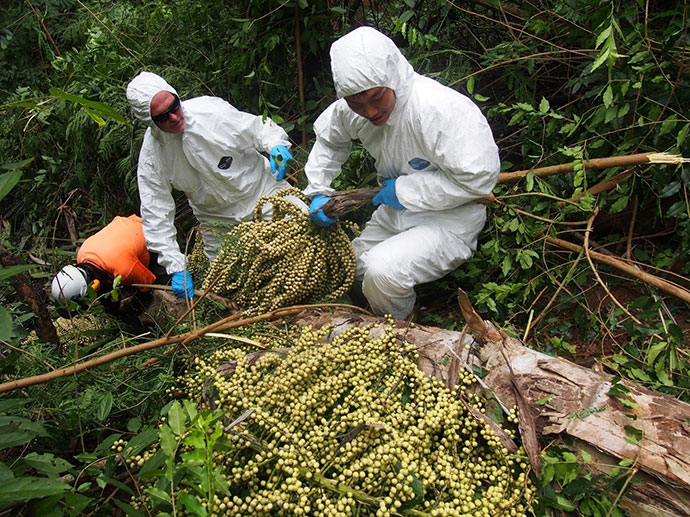
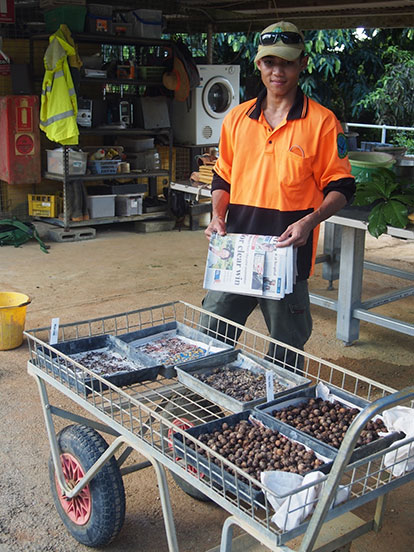
Norfolk Island
Norfolk Island is a remote subtropical island in the South Pacific with over 40 plant species listed as threatened under the Environment Protection and Biodiversity Conservation Act (EPBC Act 1999), and thus a high priority for ex situ conservation. Recently the National Seed Bank, in partnership with colleagues from Parks Australia at Norfolk Island National Park, the University of Queensland, and Friends of the ANBG, assisted in the writing and development of a guidebook for propagation of Norfolk Island's native plants and seeds. Most species outlined in the guidebook are endemic and listed as protected under the EPBC Act. This guidebook captures local knowledge and summarises insights developed by practitioners, researchers, and gardeners. Several species included have cultural significance on Norfolk Island, including Wikstroemia australis (Kurrajong), Hibiscus insularis (Philip Island Hibiscus), and Rhopalostylis baueri (Niau Palm).
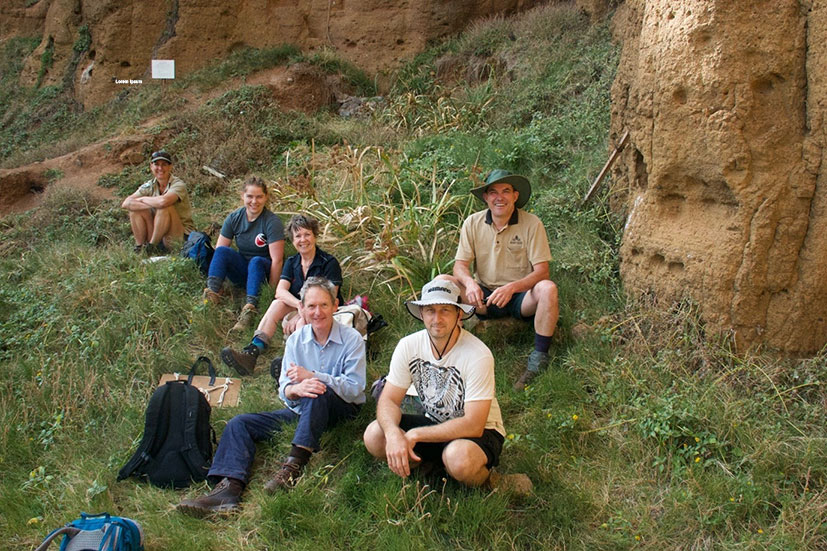
Left to right: Melinda Wilson, NRM Manager, Norfolk Island; Leah Dann, PhD Student, NSB, UQ; Leigh Murray and John Fitzgerald, NSB Seedy Volunteers; Mark Scott, Norfolk Island Nursery Manager; Toby Golson, ANBG Horticulturist.
Kakadu
As Australia's largest national park, Kakadu has been the focus of seed collecting for the National Seed Bank since 2013. Seed collecting trips to Kakadu have targeted threatened, endemic and culturally significant species. As a result, the National Seed Bank now have significant collections of Hibiscus brennanii and Acacia equisetifolia. Accessions secured from as many individuals as possible aim to capture most of the genetic diversity for these critically endangered species. Research into how to germinate Hibiscus brennanii seed has demonstrated complex seed dormancy and provided insight into how this species might persist in the wild.
Booderee
The National Seed Bank team has undertaken targeted collecting of seed from species from Booderee National Park that occur in coastal heathlands, an ecosystem prone to frequent fires. We have managed to collect species that have been underrepresented in seed banks, including a first-time collection of Dracophyllum oceanicum, which was previously thought to be sterile. With this and other heath species in the seed bank we have a chance to undertake germination research and secure against their loss in the wild. Collections from Booderee National Park were made in consultation with the traditional custodians of the Wreck Bay area and we continue to work with them by sharing seed conservation knowledge.
Uluru-Kata Tjuta
The National Seed Bank team have recently begun seed collecting work in Uluru-Kata Tjuta National Park, adding Australia's desert flora to our collection. Working in collaboration with Anangu Traditional Owners is an important part of seed collecting in this jointly managed park. Knowledge exchange or 'two-way' learning out on Country has already led to some significant seed collections of new and culturally important species for the National Seed Bank and provided opportunities for Anangu rangers to learn new skills and share their culture and connection to Country. A trip in 2023 made the first seed collections of mistletoe recorded in an Australian seed bank and we are now working to better understand their biology for storage and germination. All seed collections from Uluru-Kata Tjuta National Park are germination tested in the National Seed Bank laboratory. We aim to assist Anangu with propagation information about species of interest to facilitate growth of culturally significant plants on Country.
Tropical Mountain Plants
The application of seed banking is now expanding to species that were previously assumed too difficult to store and germinate, and to environments that are currently under-represented in seed bank collections but are facing threats and global change. One such area is the tropical mountain cloud forests of the Wet Tropics World Heritage Area of northeast Queensland. These forests contain over 70 vulnerable, endemic plant species. With partners from James Cook University, the Australian Tropical Herbarium and the Australian Institute of Botanical Science we are working to secure the future of Australia's climate-threatened tropical mountaintop plants by building a multi-strategy, ex situ conservation reserve to provide a 'backup' for at-risk wild populations, and to support associated research, display and education. The project was nominated for a 2023 Eureka Prize for Excellence in Botanical Science.
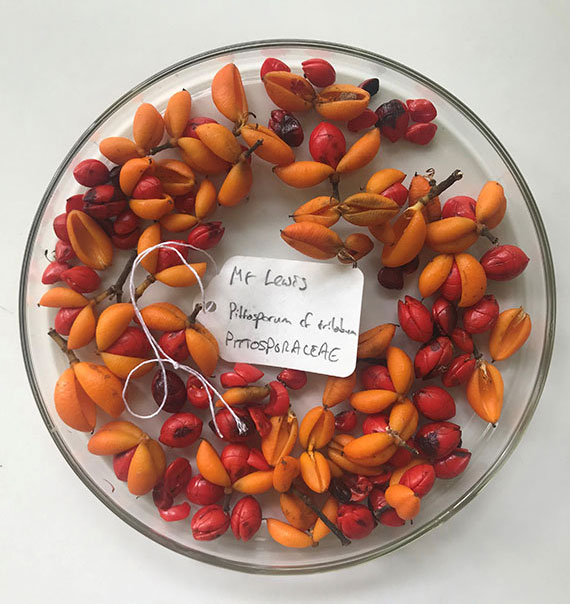 |
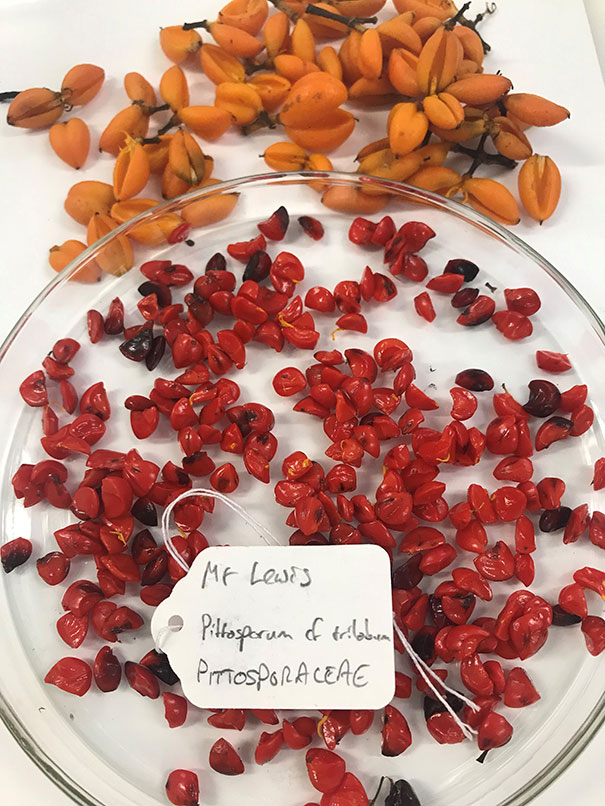 |
Fleshy fruits and seeds of Pittosporum trilobum (Pittosporaceae) collected in the Wet Tropics World Heritage Area of northeast Queensland. |
|
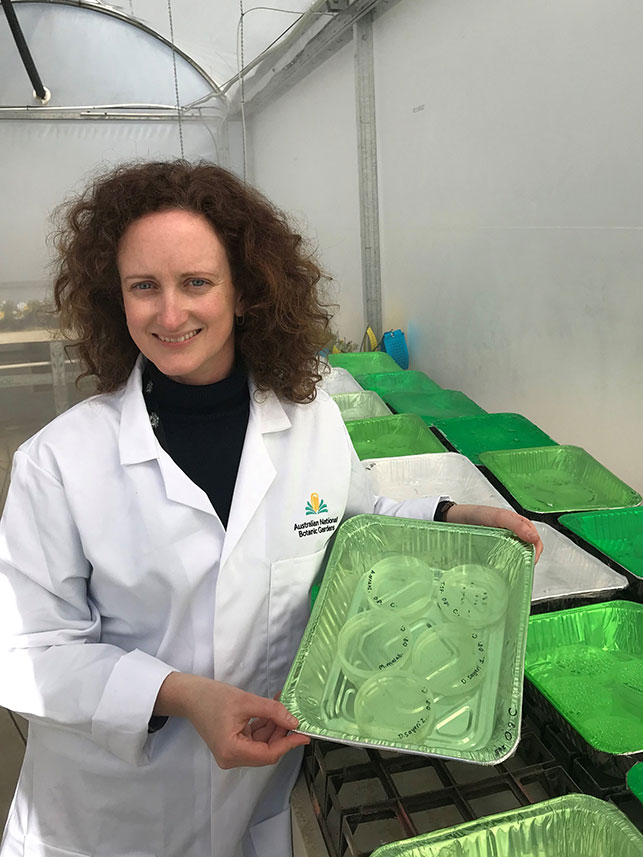 |
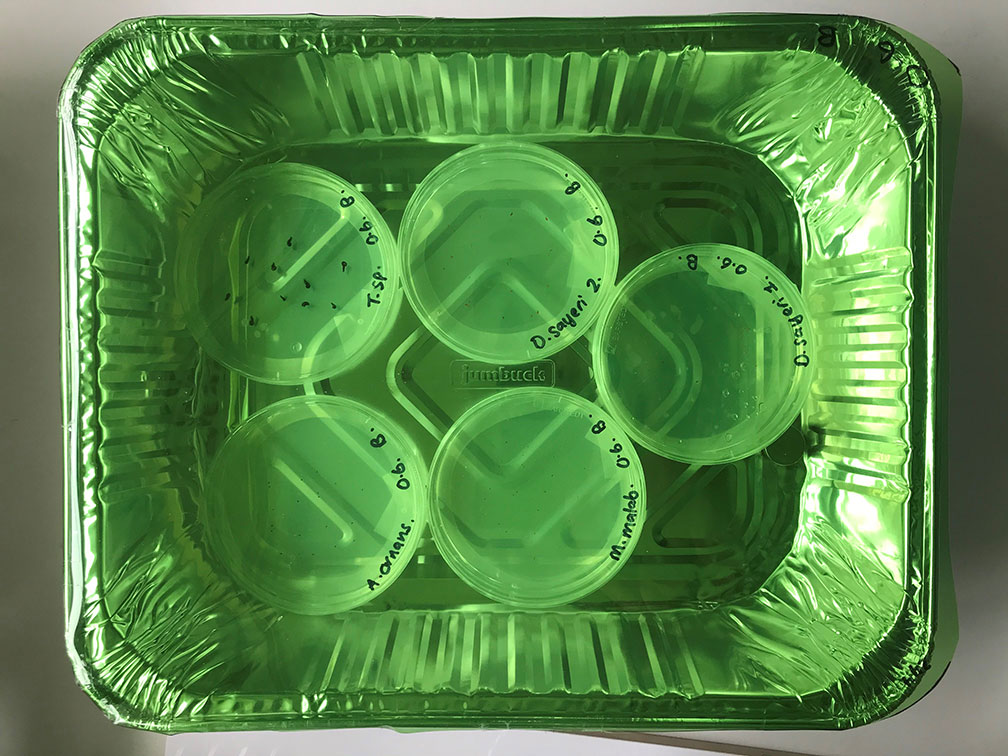 |
Investigating the effect of light quality (the ratio of red to far-red light, as determined by canopy cover and cloud immersion) on germination of seeds from tropical mountain cloud forests. |
|
Digital Images of Australian Native Seed
"Australian native seeds: a digital image library" was initiated with funding from the Bush Blitz species discovery program, which provided support to capture images of seed from 1000 Australian native plant species. Photograping seed accessions at the National Seed Bank is now an ongoing activity, along with collecting associated trait data to better understand our native seeds. Images of the initial 1000 species and an increasing number of other seed images are available from the Australian Plant Image Index (APII) under a Creative Commons licence (CC-BY) with attribution to the National Seed Bank and acknowledging support from Bush Blitz. More information on this project and the descriptions and standards for the seed traits measured is available in PDF format. To search the APII exclusively for seed images use the full search, in the 'class' field use the query value 'nsb', and add the name/s of a genus or species of interest to the relevant field/s. For example, this link shows the results of a search for NSB images of Hibiscus, sorted alphabetically. The trait data obtained through this work has formed part of the new AusTraits database.
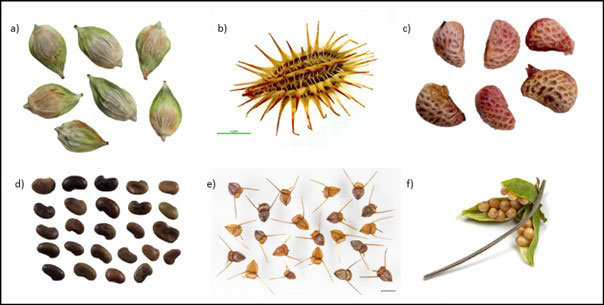
Student Research Projects
The National Seed Bank values working with tertiary students and offers positions for student projects each year. We provide opportunities for rewarding and important work, and training in specialist skills in conservation seed banking and research. If you are a student or university supervisor interested in seed conservation and research, please contact us to discuss possible projects. As well as work placements for trainees we can also co-supervise honours, masters or PhD students: see examples below.
Current Students
- Leah Dann
Ecological evaluation of threatened plants on Norfolk Island. University of Queensland. Supervisors S Kark (UQ), N Levin (UQ), J Dwyer (UQ) and L Guja (CANBR/ANBG).
Past students
PhD
- Joshua Hodges (2019–2023)
Grassy woodland seed biology. Charles Sturt University and Australian National University. Supervisors J Price (CSU), AB Nicotra (ANU), and L Guja (CANBR/ANBG).
- Annisa Satyanti (2014–2018)
A multi-scale exploration of the drivers and implications of germination strategy in Australian alpine plants. Australian National University. Supervisors AB Nicotra (ANU) and L Guja (CANBR/ANBG).
Hons
- Alex McLachlan (2022 H1)
Effects of increased temperatures on Australian alpine Euphrasia's seed dormancy, germination, and viability. University of Canberra. Supervisors W Higgisson (UC), F Dyer (UC), L Guja (CANBR/ANBG) T North (ANBG).
- Amy Buckner (2021 H1)
Do fire-cues promote germination and emergence in Australian alpine seed? Australian National University. Supervisors AB Nicotra (ANU) and L Guja (CANBR/ANBG).
- Jason Chan (2018 H1)
Drivers of variation in seed dormancy and germination of rare Pomaderris. University of New South Wales. Supervisors M Ooi (UNSW) and L Guja (CANBR/ANBG).
- Joshua Hodges (2017 H1)
Variable germination responses to fire-cues and dormancy alleviation in perennial forbs from temperate grassy ecosystems. Charles Sturt University. Supervisors J Price (CSU), D Nimmo (CSU) and L Guja (CANBR/ANBG).
- Gabrielle Vening (2016 H1)
Addressing seed dormancy in three grassy woodland forbs. Charles Sturt University. Supervisors J Price (CSU), P Spooner (CSU) and L Guja (CANBR/ANBG).
- Amelia Stevens (2016 H1)
Will polyploidy provide a reproductive advantage in a changing climate? A test case with Themeda triandra (Kangaroo Grass). Australian National University. Supervisors AB Nicotra (ANU), R Godfree (CSIRO) and L Guja (CANBR/ANBG).
Recent research publications
2023
Dann LE, Guja LK, Kark S, Dwyer J (2023) Comparative study reveals management of a dominant invasive plant facilitates subtropical forest regeneration. Biological Invasions 1–15 https://doi.org/10.1007/s10530-023-03174-5
Guja LK, Ooi MKJ, Norton SL, Wrigley D, Desmond B, Offord CA (2023) Seed science in Australasia: regionally important, globally relevant. Australian Journal of Botany 71(7): 319–325 https://doi.org/10.1071/BT23075
Fernández-Pascual E, Carta A, Rosbakh S, Guja LK, Phartyal SS, Silveira F, Chen S, Larson J, Jimenez-Alfaro B (2023) SeedArc, a global archive of primary seed germination data. New Phytologist 240(2): 466–470 https://doi.org/10.1111/nph.19143
Hoyle GL, Sommerville KD, Liyanage GS, Worboys S, Guja LK, Stevens AV, Crayn DM (2023) Seed banking is more applicable to the preservation of tropical montane flora than previously assumed: A review and cloud forest case study. Global Ecology and Conservation 47. E02627
Hoyle GL, Bredell P, Stevens AV, Cook E, Knapp Z, Guja LK (2023) Ex situ conservation breakthrough at the Australian National Botanic Gardens. Australasian Plant Conservation 32(1): 3–7
Hoyle GL, Stevens AV, Guja LK, Sommerville KD, Worboys S, Crayn DM (2023) Sunlight and red to far-red ratio impact germination of tropical montane cloud forest species. Australian Journal of Botany 71: 326–339 https://doi.org/10.1071/BT22126
Hoyle GL, Hodges JA, Clinton B, Tooth R, Neeman T, Guja LK (2023) Decision support for managing conservation seed bank collections: comparing germination and viability. Seed Science and Technology 51(12): 157–180 https://doi.org/10.15258/sst.2023.51.2.02
Martin Yenson AJ, Sommerville KD, Guja LK, Merrit DJ, Dalziell EL, Auld TD, Broadhurst L, Coates DJ, Commander L, Crawford AD, Emery NJ, Funnekotter B, Knapp Z, Makinson RO, Monks L, Wrigley D, Offord CA (2023) Ex situ germplasm collections of exceptional species are a vital part of the conservation of Australia's national plant treasures. Plants, People, Planet 1–23
2022
Fuchs A, Guja LK, North T, & Stevens A (2022) Achieving better outcomes from seed bank data management systems. Australasian Plant Conservation: Journal of the Australian Network for Plant Conservation 31(2): 26–30 https://search.informit.org/doi/10.3316/informit.799348798947436
Liyanage GS, Offord CA, Crayn DM, Guja LK, Worboys S, Sommerville KD (2022) Understanding seed dormancy and germination aids conservation of rainforest species from tropical montane cloud forest: a case study confirming morphophysiological dormancy in the genus Tasmannia. Australian Journal of Botany 70: 399–408 https://doi.org/10.1071/BT22011
Chan J, Ooi M, Guja LK (2022) Polyploidy but not range size is associated with seed and seedling traits that affect performance of Pomaderris species. Frontiers in Plant Science 12: 779651 https://doi.org/10.3389/fpls.2021.779651
Hodges JA, Price JN, Nicotra AB, Guja LK (2022) Smoke and heat can increase germination of common wildflowers and grasses—implications for conservation and restoration of critically endangered grassy ecosystems. Ecological Management and Restoration 23(1): 94–99 https://doi.org/10.1111/emr.12533
2021
Martin Yenson AJ, Offord CA, Meagher PF, Auld T, Bush D, Coates DJ, Commander LE, Guja LK, Norton SL, Makinson RO, Stanley R, Walsh N, Wrigley D, Broadhurst L (2021) Plant germplasm conservation in Australia: strategies and guidelines for developing, managing and utilising ex situ collections. 3rd ed (Australian Network for Plant Conservation Inc.: Canberra)
Hodges JA, Price JN, Nicotra AB, Neeman T, Guja LK (2021) Smoke and heat accelerate and increase germination in fire-prone temperate grassy ecosystems. Ecosphere 12(12): e03851
Falster D, Gallagher R, Wenk EH, Wright IJ, Indiarto D, Andrew SC, et al. (2021) AusTraits, a curated plant trait database for the Australian flora. Scientific Data 8(1): 1–20
Godfree RC, Knerr N, Encinas-Viso F, Albrecht D, Bush D, Cargill DC, Clements M, Gueidan C, Guja LK, Harwood T, Joseph L, Lepschi B, Nargar K, Schmidt-Lebuhn A, Broadhurst LM (2021) Implications of the 2019–2020 megafires for the biogeography and conservation of Australian vegetation. Nature Communications 12(1): 1–13
Satyanti A, Liantoro T, Thomas M, Neeman T, Nicotra AB, Guja LK (2021) Predicting effects of warming requires a whole-of-life cycle perspective: a case study in the alpine herb Oreomyrrhis eriopoda. Conservation Physiology 9(1): coab023
2020
Fernández-Pascual E, Carta A, Mondoni A, Cavieres L, Rosbakh S, et al. (2020) The seed germination spectrum of alpine plants: a global meta-analysis. New Phytologist 229(6): 3573–3586
Chong C, Stevens A, Grigg A, North T, McAuliffe J, Guja L (2020) Ex situ conservation of a critically endangered fern. Australasian Plant Conservation 29(3): 16–19
Stevens A, Nicotra A, Godfree R, Guja L (2020) Ploidy affects the seed dormancy and seedling characteristics of a perennial grass, conferring an advantage in stressful climates. Plant Biology 22(3): 500–513
2019
Price J, Good M, Schultz N, Guja L, Morgan J (2019) Turner review: Multivariate drivers of diversity in temperate Australian native grasslands. Australian Journal of Botany 67(5): 367–380 https://doi.org/10.1071/BT18190
Hodges JA, Price JN, Nimmo DG Guja LK (2019) Evidence for direct effects of fire-cues on germination of some perennial forbs common in grassy ecosystems. Austral Ecology 44(7): 1271–1284 https://doi.org/10.1111/aec.12806
Chen S, Guja L, Schmidt-Lebuhn A (2019) Conservation implications of widespread polyploidy and apomixis: a case study in the genus Pomaderris (Rhamnaceae). Conservation Genetics 20(4): 917–926
Satyanti A, Guja LK, Nicotra AB (2019) Temperature variability drives within-species variation in germination strategy and establishment characteristics of an alpine herb. Oecologia 189(2): 407–419
Smith AL, Kujala H, Lahoz-Monfort JJ, Guja LK, Burns EL, Nathan R, Alacs E, Barton PS, Bau S, Driscoll DA, Lentini PE, Mortelliti A, Rowe R, Buckley YM (2019) Managing uncertainty in movement knowledge for environmental decisions. Conservation Letters 12: e12620. https://doi.org/10.1111/conl.12620
2018
Saatkamp A, Cochrane A, Commander L, Guja LK, Jimenez-Alfaro B, Larson J, Nicotra AB, Poschlod P, Silveira FAO, Cross AT, Dalziell EL, Dickie J, Erickson TE, Fidelis A, Fuchs A, Golos PJ, Hope M, Lewandrowski W, Merritt DJ, Miller BP, Miller RG, Offord CA, Ooi MKJ, Satyanti A, Sommerville KD, Tangney R, Tomlinson S, Turner S, Walck JL (2018) A research agenda for seed-trait functional ecology. New Phytologist 221(4): 1764–1775
Offord CA, Guja LK, Turne, SR, Merritt DJ (2018) Seeds at the forefront: Synthesis of the inaugural National Seed Science Forum and future directions in Australian seed science. Australian Journal of Botany 65(8): 601–608
Satyanti A, Nicotra A, Merkling T, Guja LK (2018) Seed mass and elevation explain variation in seed longevity of Australian alpine species. Seed Science Research 28(4): 319–331
Vening GS, Guja LK, Spooner P, Price JN (2018) Seed dormancy and germination of three grassy woodland forbs required for diverse restoration. Australian Journal of Botany 65(8): 625–637
Seed Bank databases
Native seed information, collection records and images can be found in our online database and from the associated following sources:
- National Seed Bank
- Australian Virtual Seed Bank, hosted by Atlas of Living Australia
- SeedArc
- Seed Information Database (SID), hosted by the Society for Ecological Restoration
- Millennium Seed Bank Partnership Data Warehouse
- Australian Plant Image Index
- AusTraits
Supply of seed from the National Seed Bank
The National Seed Bank can supply seed for approved research (not for profit) projects at other botanic gardens, universities and similar institutions subject to submission of a satisfactory permit application. Seed cannot be supplied to private individuals.
Applications for seed of species listed as threatened under the EPBC Act are assessed separately under an EPBC permit application.
National Seed Bank contacts
For all enquiries to the National Seed Bank (including requests for seed release and enquiries about volunteering) please contact the National Seed Bank team via info@anbg.gov.au.
If you would like to enquire about more general opportunities to volunteer at the Australian National Botanic Gardens, please contact volunteer@anbg.gov.au.
![Director of National Parks [logo]](../../../images/dnp_90px.gif)





